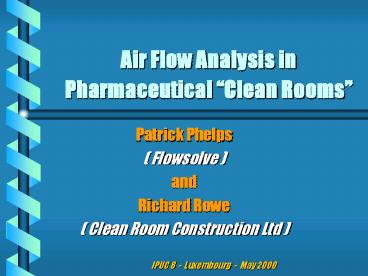Air Flow Analysis in Pharmaceutical Clean Rooms - PowerPoint PPT Presentation
1 / 48
Title:
Air Flow Analysis in Pharmaceutical Clean Rooms
Description:
Air Flow Analysis in Pharmaceutical 'Clean Rooms' Patrick Phelps ( Flowsolve ) and ... Design and performance of air supply, filtration, and extraction arrangements ... – PowerPoint PPT presentation
Number of Views:78
Avg rating:3.0/5.0
Title: Air Flow Analysis in Pharmaceutical Clean Rooms
1
Air Flow Analysis in Pharmaceutical Clean Rooms
- Patrick Phelps
- ( Flowsolve )
- and
- Richard Rowe
- ( Clean Room Construction Ltd )
IPUC 8 - Luxembourg - May 2000
2
Air Flow Analysis in Pharmaceutical Clean Rooms
- Industrial Context
- Health and Safety Issues
- Application to an Existing Room
- Application to New Ventilation Designs
- Conclusions
- Experimental Verification
3
Clean Rooms
- Areas concerned with the
- preparation, processing and packaging
- of pharmaceutical products
- Strict codes of practice employed to eradicate
risk of product contamination
4
Clean Rooms
- Personnel access controlled
- 2-layer sterile over-clothing
- Equipment sterilised before entry
- Strict cleansing procedures
- Particular attention to ventilation
5
Ventilation of Clean Rooms
- Design and performance of air supply, filtration,
and extraction arrangements must meet exacting
standards - Positive pressure areas
- Use of Laminar Flow Units (LFUs)
6
Laminar Flow Units
- Devices which deliver a controlled
- down-draught of re-filtered air
- over sensitive regions
- preparation areas
- processing areas
- packaging areas
- storage areas
7
Air Flow Analysis in Pharmaceutical Clean Rooms
8
CFD Application to Air Flow Analysis in Clean
Rooms
- Context
- Upgrade of ventilation system in
- a suite of clean rooms at a
- UK pharmaceutical company
9
CFD Application to Air Flow Analysis in Clean
Rooms
- Objective
- Use CFD to ensure exacting requirements
- can be met , following installation of a
- number of LFUs .
10
CFD Application to Air Flow Analysis in Clean
Rooms
- Workscope
- 3 rooms selected as representative
- examples of areas being upgraded
- Room 30
- Room 23
- Room 42
11
Modelling Considerations - 1
- Irregular shaped domains
- Internal Obstructions to flow
- Cartesian grid employed
- K-e (Chen) turbulence model used
- Buoyancy important in transient
- (otherwise assume isothermal)
12
Modelling Considerations - 2
- Dependent variables solved
- pressure, p
- lateral velocity component, U
- vertical velocity component, V
- Longitudinal velocity component, W
- Turbulence kinetic energy, k
- Turbulence energy dissipation rate, e
- residence time parameter, tres
- (temperature, T (for transient)
13
Modelling Considerations - 3
- Boundary Conditions
- Air supply ducts
- prescribed sources of mass, momentum, turbulence
and residence time - Air Extract ducts
- specified fixed-pressure outlet sinks
- LFUs
- inlets and outlets specified as above
14
Representation of LFUs
- Air flow in individual units not solved
- treated as internal blockages in domain
- air discharged from base at prescribed rate
- matching intake from front face
- interactive updating of discharge residence time
- constant internal residence time assumed
15
Room 30
- Small room - 4.94 x 5.94 x 2.92 m.
- Used for processing, filling and packaging of
products - Contains central plinth with filling-machine
enclosure above - Conveyor-linked trays outboard of enclosure, for
containers finished goods
16
Room 30 - Before
17
Room 30 Simulations
- Steady flow patterns before
- LFUs in enclosure only
- Steady flow patterns after
- following fitment of 10 new LFUs
- 75,000 node 3-D model
- Distribution 50 x 30 x 50
18
Room 30 - After
19
Room 30 Simulations
- Objectives
- Check for dead zones
- ensure ventilation criteria met
- Criteria
- 25 Air changes per hour
- (residence time 144 seconds)
20
Room 30 - Sectional Planes
21
Room 30 - Before
22
Room 30 - After
23
Room 30 - Before
24
Room 30 - After
25
Room 30 - Before
26
Room 30 - After
27
Room 30 - Before
28
Room 30 - After
29
Room 30 - Before
30
Room 30 - After
31
Room 30 - Before
32
Room 30 - After
33
Room 30 - Before
34
Room 30 - After
35
Room 30 - Before
36
Room 30 - After
37
Room 30 - Before
38
Room 30 - After
39
Room 30 - Before
40
Room 30 - After
41
Room 30 Ventilation Summary(after refurbishment)
- Complex flow paths between inlet and outlet
- Pattern complicated by LFU intake extraction
flows - air has to pass around central plinth and
filling-machine enclosure - air in near-side passage has to run gauntlet of
LFUs
42
Room 30 Ventilation Summary(after refurbishment)
- Outflow-weighted residence time of 121 seconds
meets client criterion - near extract air considerably older than
far extract air - some dead zones still apparent
- evidence of entrainment into more than one unit
43
Dead Zones - before
44
Dead Zones - after
45
LFU intake times - 1
46
LFU Unit intake times - 2
47
LFU Unit intake times - 3
- Units D1, D2, B2, C2, A1 receive considerably
fresher air than their neighbours A2-A4, B2 and
C1 - Air entering A4 is 2.2 times older than that
entering D1 - Air leaving A4 exceeds air-change criterion en
route to outlet
48
Conclusions
- Residence time analysis concept adds
considerable value to vector and contour plots in
assessment of complex ventilation flows.































